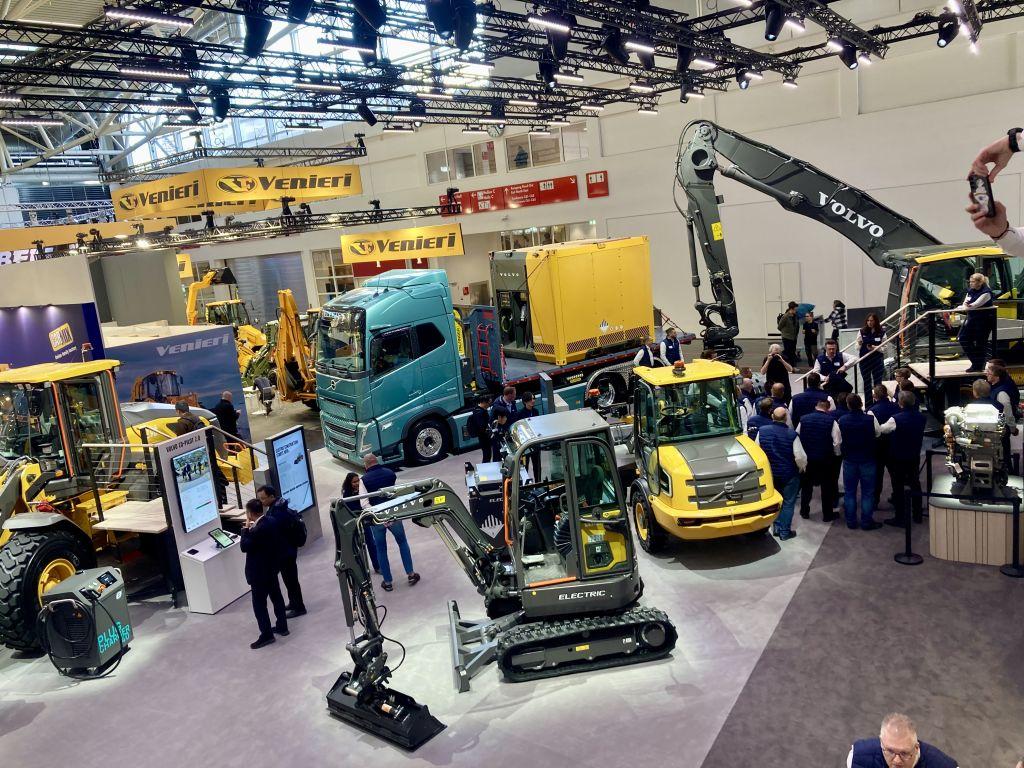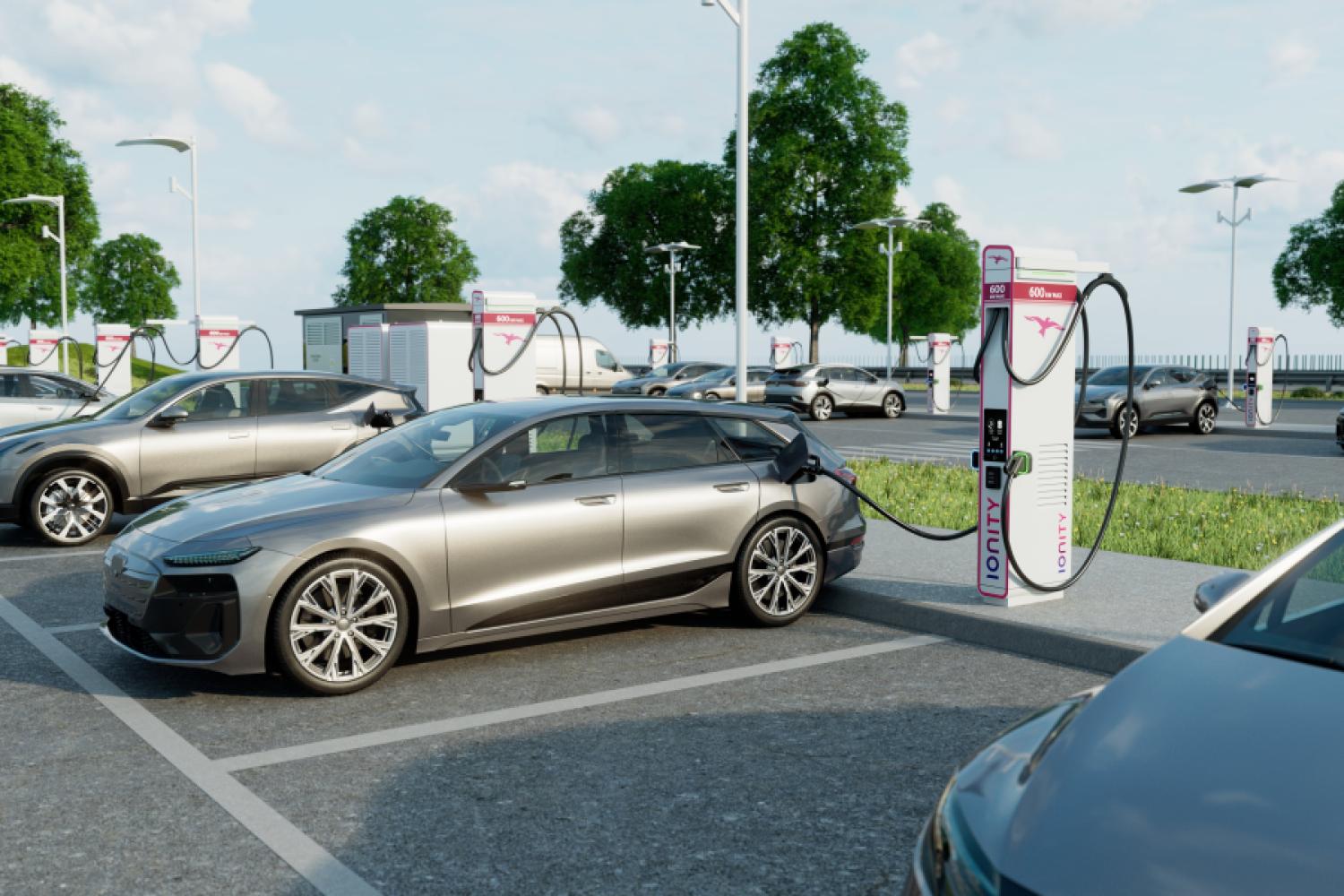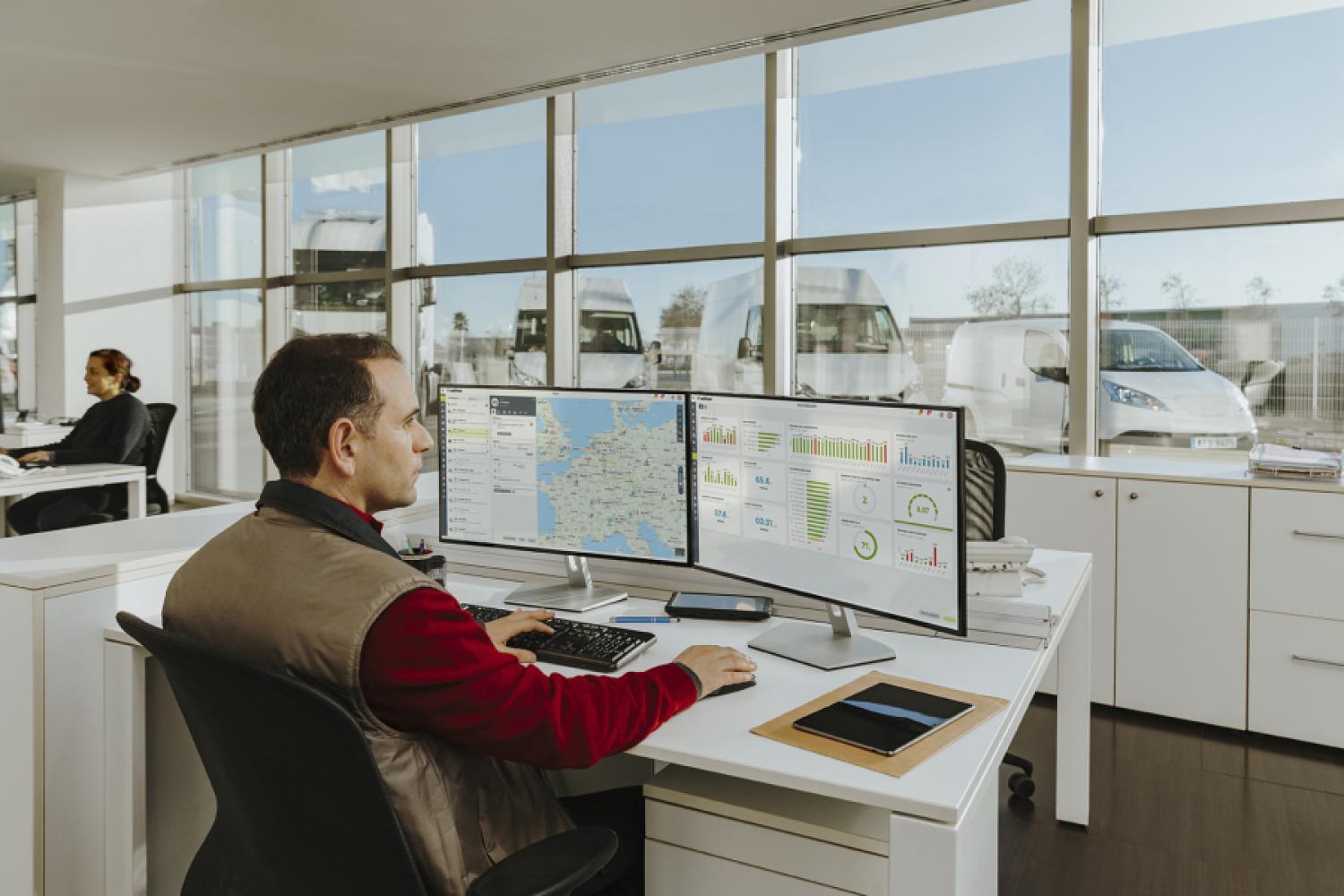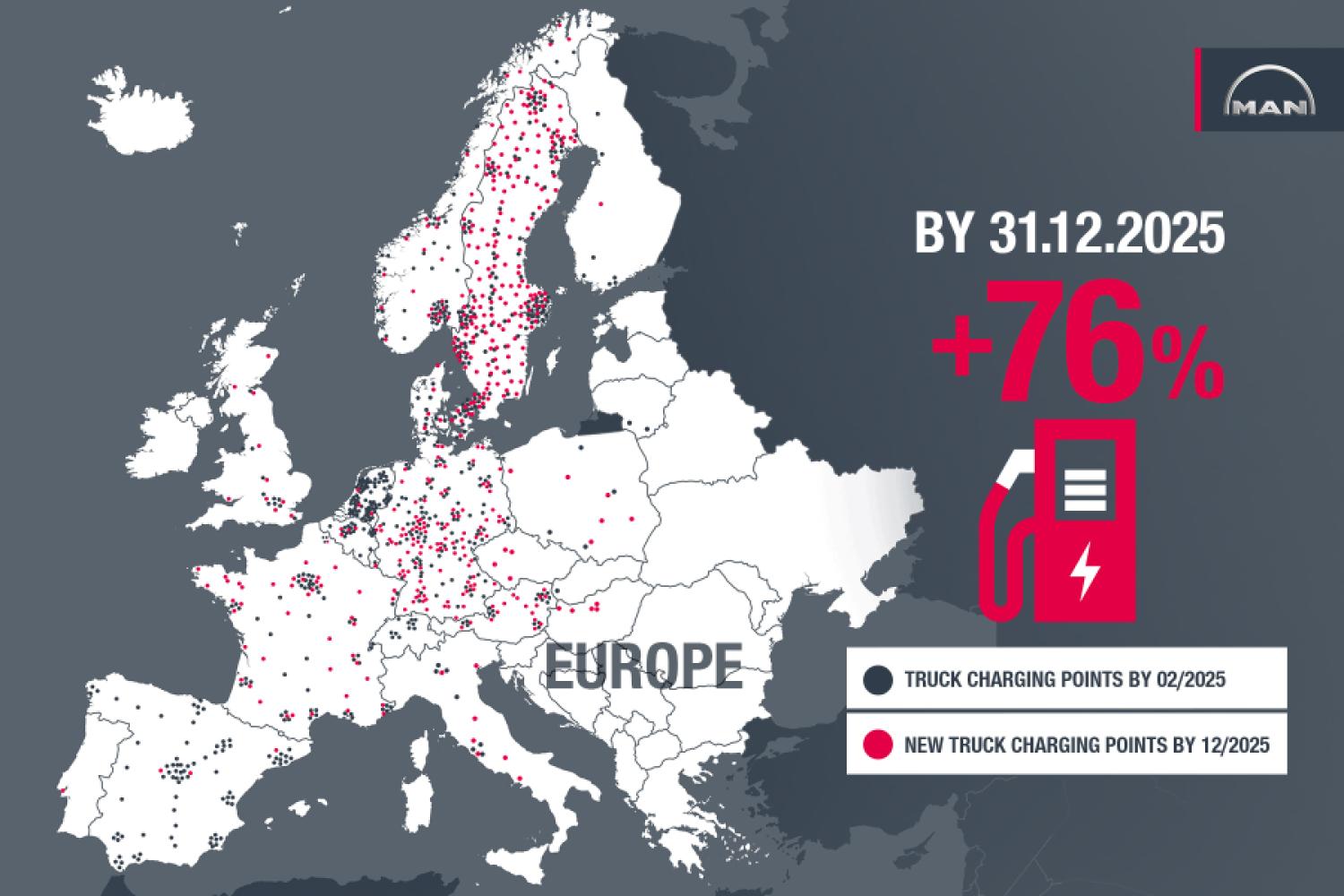For truck manufacturers, Bauma is not the most important trade fair, which was reflected in their presence and stand size: Daf, Iveco, and Renault were not present at all, MAN only had a small outdoor stand, Volvo Trucks participated as a "junior partner" of the construction machinery section, and Daimler Trucks also reduced their stand somewhat. The same was true for Scania, although they still allowed themselves a decent amount of space. Surprise: Ford was in the outdoor area, and Tatra returned to its stand in Hall B4 to showcase the new Phoenix.
Daimler Trucks: From the Fuso e-Canter to the heavy-duty tractor unit for 1,000 tons
So let's start in the halls and then move to the outdoor area: Mercedes-Benz showcased the eArocs 400 as a mixer, developed together with Paul: The Bavarian conversion experts can practically do "everything". However, the construct raised some questions: The basis is the high construction chassis with portal axles – which already raises the center of gravity with a combustion engine mixer. If the battery pack also sits behind the cabin, it doesn’t help in delaying the ESP intervention due to the risk of tipping over. However, mixers are generally well-suited for electrification: They generally have manageable distances and often operate in urban areas, where more and more emission-free and “quiet” work is required. The same applies to concrete pumps, of which Volvo showed one. In that respect, the eArocs is initially more to be considered as a “yes, we can” - expected to begin pre-series deployments from 2026 onwards.
In the outdoor area, they also showcased a diesel-powered heavy-duty application of the Arocs, capable of towing up to 1,000 tons gross weight – the upper limit was usually 250 tons before. At the other end of the Daimler Trucks spectrum stood various Fuso Canter distributors, which are increasingly being ordered electrically for urban and municipal use. That’s why Fuso continuously expands the range of variants.
Volvo Trucks: Strong “E-Toolbox” for all applications
It’s different at Volvo Trucks, where a battery propulsion concept has been developed that can be integrated into any vehicle, although the very off-road high chassis are still excluded. Nevertheless, the Swedes are currently leading the way in electrification: The next stage of expansion is supposed to be a long-haul version of the FH with a range of up to 600 kilometers, although Thomas Tschakert, PR Expert Press Test & Product Volvo Trucks, notes: “Even in long-distance transport, electromobility always needs defined routes.” Otherwise, charging remains a challenge. However, more and more customers are experiencing hub-to-hub traffic, where electricity can always be drawn during loading and unloading. And those who have a lot of solar power on their warehouse roofs – AND the necessary buffer storage – are already saving a lot of money, according to Tschakert, because they are quite energy-autonomous. Which is necessary, as the prices for electric trucks are ideally 2 to 2.5 times higher than those of diesel counterparts, depending on the manufacturer.
Scania showed Diesel, Electric, and Biomethane
That Sweden is leading in the transition of drives was also demonstrated by Scania: Of course, they also showcased the 770-hp heavy-duty tractor unit with the legendary (last remaining series) V8 diesel, but next to it parked an electric series three-axle vehicle with a Meiller-Trigenius three-way tipper and the necessary charging station.
However, Scania can do even more: They continue to advance the topic of biomethane—with a three-axle tractor unit that is now supposed to offer a range of up to 750 kilometers. Absolutely not very much—but relatively speaking—for biomethane—but still. Additionally, there were more—also electrified and electric drivetrains for external customers who rely on Scania power.
Tatra Trucks: Premiere of the new Phoenix—long live the central tube frame!
A subject that doesn't concern Tatra at the moment: It can be considered a small miracle that the Czechs are still standing their ground, even though the “Phoenix,” with which they rose from the niche in the hardcore sector, is essentially a rebranded Daf XF, under which the Tatra central tube frame was added. Which massively increases the circulation speeds offroad: Indeed, a Tatra can be moved noticeably faster offroad than any standard ladder-frame truck, as we were able to “experience” ourselves on several test drives in Moravia on Tatra's treacherous offroad terrain and in German pits. On the drive side, they use the latest generation of Paccar engines, cleaned according to Euro 6e. And with the cabin, Tatra benefits from Daf Trucks’ push towards premium.
MAN: Modest home game in Munich
MAN presented itself as almost “modest” at its “home game” in Munich: On a narrow strip on the outdoor area, they showcased exciting variations of the current range: A TGX 33.640, highly upgraded by “MAN Individual” (adopting the designation from another Munich vehicle manufacturer with whom they once swapped and shared software engineers), was displayed, along with a 202 HP all-wheel-drive version of the TGE and a heavy TGS 41.480 BB CH with a heavy KH tipper for mining use. And, of course, they also had an electric vehicle with a charging station at the stand: The eTGS 28.449 6x2*4 BL CH EB—a three-axle crane tipper, aimed at regional and urban operations, thus showing great potential as an electric vehicle. This is how MAN ventured into an exciting yet absolutely worthwhile niche.
Ford Trucks is now also venturing into chassis
Ford Trucks has not reached this point yet: In the outdoor area, Ford also showcased a customized F-Maxx Select for long-haul transportation, along with two F-Line 8x4 4145L: one with a Meiller-Trigenius three-way tipper and one with a Liebherr mixer. The message is clear: after a successful start with tractor units in the affordable segment, Ford's Turkish Otosan arm is now also venturing into chassis. At the Commercial Vehicle IAA, they also presented an idea of an electric version. However, that might become more concrete with the next generation. Behind the scenes, it is heard that Ford is already developing the next entirely new F-Generation for 2028, whose cabin is also supposed to replace the current shell at Iveco (which in its basic features still dates back to 1990). To what extent Ford and Iveco will consolidate their activities in electric vehicles remains open. The fact is: In Ulm, the production line of the electric S-eWay has been switched from 'only tractor units' to 'also chassis'.
Premiere: the first purely electric suction excavator on Framo chassis
Sany also hopes for approval here: The Chinese exhibited the electric e435 8x4 chassis for tippers and mixers. Also fascinating was the first purely electric suction excavator from RSP on a four-axle Framo chassis. Here too, the routes generally remain manageable, and the city is pleased about significantly quieter suction noise.
And hydrogen? According to Tschakert, it also comes more in internal combustion engines at Volvo, which can be comparatively easily converted – the fuel cell is not really efficient, extremely expensive, and hardly delivers the necessary performance. Hyundai would disagree here: Alongside the new 15-ton mobile excavator HW155H, they presented a three-axle Xcient chassis that serves as a mobile hydrogen refueling station. Thus, the Hyundai Group continues to fly the hydrogen or fuel cell flag not only for passenger cars but also for excavators and trucks.
What does this mean?
Even if the topic of electromobility in trucks is getting off to a rather subtle start: especially in the construction sector, there are numerous very concrete applications. And also customers willing to take this bold step and convert. The prerequisite for this is defined routes and assignments. In the long term, it is expected that more and more cities and municipalities will insist on electric applications and that the technology will continue to develop significantly.






